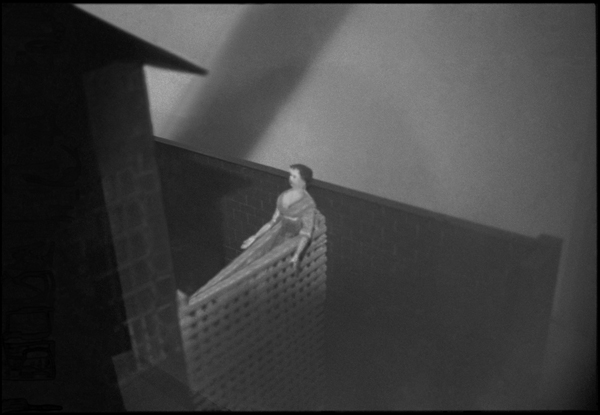New York artist Barbara Rosenthal’s photographic series Trapped Figures and Tiny Houses kept their eerie vigil at Visual Voice Gallery over the weekend.
In a section taken from the Old Europe series are night photographs of Stare Mesto in Prague, but only the tops of the buildings, keeping us suspended too high up for comfort. The line of stone buildings is slightly broken near the middle; there is a disjuncture that won’t allow us to put it together completely. On another wall, single houses in meadow landscapes threaten to slide right out of the frame, as the horizon has banked at a sharp angle. Inside, things are no less odd: in an almost voyeuristic way we apprehend doll figures within restrictive architectures, the slants and incoherent spaces of which transmit the sense of ill-ease that the figures’ blank expressions cannot.
These images summon the Freudian concept of the uncanny, where familiar things are imbued with a strangeness at the same time. It is for this reason that the house, the seat of domestic comfort, is the most potent vehicle for the uncanny. Moreover, these images are devoid of people; the only figures are dolls, and these worlds seem eerily quiet. But these pictures have a style or personality, I thought. It seems to come from the consciousness–or, as the artist might say, the subconscious–that operates the camera, directs the focus, slants the horizons…Rosenthal has indeed remarked that “I gave my subconscious a camera and promised not to interfere.” Keeping this in mind as you peer into these strange worlds only adds to their piquancy.
I like the idea of giving your subconscious free rein to capture and create the world. Taking such a risk you may end up with a corpus of work that is strange even to yourself. As Rosenthal recounted, her photographic subjects–like the trapped figures, houses on slanted horizons, dark Europe, sinister spaces– aggregated over time rather than systematically collected under a predetermined rubric. They began to resolve into such categories through the making of her books, a few of which were available for perusal at the exhibition. The books seem to be something like a discursive counterpoint to her pictures, another means of making art and making sense of it. Reading the photographs and books together is an interesting look at the artist’s process.
Rosenthal has practiced photography for decades and has recently begun to employ digital technology by scanning the negatives (which she still develops herself). The scans have allowed for greater sleight of hand in adjusting the photographs, but its impact is subtle; the format is still 18×20 and the wonderful hand-made-ness of the photograph that we all long for remains.
The show runs until November 14th. Come and have an unheimlich look.
Visual Voice Art Gallery, space 421
Barbara Rosenthal
Trapped Figures + Tiny Houses
October 29 – November 14, 2012
www.visualvoicegallery.com




1 Comment
Comments are closed.